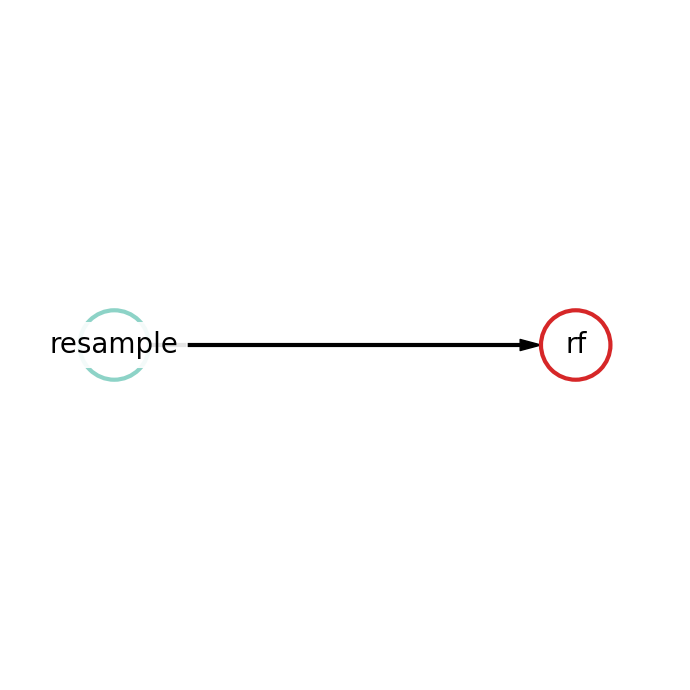Classification example
This example explains how to solve classification task using Fedot.
Generally Fedot provides a high-level API that enables you to use common fit/predict interface. To use API it is required to import certain object:
from fedot import Fedot
Then we have to load data and split it on train and test set.
Fedot uses it’s own data object notation (InputData). It contains index,
features and target for each sample. You can create it from file using InputData.from_dataframe() method.
You need to provide Task object with type of task you want to solve.
You also can find another ways of data passing in this example <data>.
from fedot.core.data.data import InputData
data = InputData.from_dataframe(features_df,
target_df,
task=Task(TaskTypesEnum.classification))
train, test = train_test_data_setup(data)
Note
There are 3 possible values for TaskType: * TaskTypesEnum.classification * TaskTypesEnum.regression * TaskTypesEnum.ts_forecasting
Initialize the FEDOT object and define the type of modeling problem. In this case, problem is classification.
You also can define metric parameter (ROC-AUC in this example), timeout in minutes (in this example we limit fedot for 5 minutes).
model = Fedot(problem='classification', metric='roc_auc', timeout=5)
Note
Class Fedot.__init__() has more, e.g.
n_jobs for parallelization. For more details, see the FEDOT API section in our documentation.
To train our model we should call method fit(). This method returns the best pipeline was obtained during optimization.
best_pipeline = model.fit(features=train)
After the fitting is completed, you can look at the structure of the resulting pipeline. For example, let best pipeline consist of two nodes: resampling operation (resample) and Random Forest (rf). Let see how it looks like.
In text format:
best_pipeline.print_structure()
Pipeline structure:
{'depth': 2, 'length': 2, 'nodes': [rf, resample]}
rf - {'n_jobs': -1, 'bootstrap': False, 'criterion': 'entropy', 'max_features': 0.2452946642710205, 'min_samples_leaf': 6, 'min_samples_split': 4, 'n_estimators': 100}
resample - {'balance': 'expand_minority', 'replace': False, 'balance_ratio': 0.5984630982827773}
And in plot format:
best_pipeline.show()
To obtain prediction for test data you need call predict() or predict_proba() method from Fedot class.
Since we want to calculate ROC-AUC metric for our test data we should use predict_proba() method.
prediction = model.predict_proba(features=test)
if visualization:
auto_model.plot_prediction()
Hint
If you want to predict target labels use predict() method.
The get_metrics() method estimates the quality of predictions according the selected metrics.
print(auto_model.get_metrics(rounding_order=4)) # we can control the rounding of metrics
Note
You may see, that get_metrics() returned not only ROC-AUC metric. You can pass names of interested metrics by
metrics_name parameter. F.e. get_metrics(metric_names=['roc-auc', 'f1']).
Since you got a prediction and calculated metrics you can plot your prediction by calling plot_prediction() method.
For classification task it plots ROC curve.
.. code-block:: python
model.plot_prediction()
You may interested to save the model. To perform that just call best_pipeline.save()
pipeline.save(path='path_to_save_and_load', create_subdir=False, is_datetime_in_path=False)
To load fitted pipeline you can invoke .load() from just initialised Pipeline object method with passing path to your pipeline.
from fedot.core.pipelines.pipeline import Pipeline
loaded_pipeline = Pipeline().load('path_to_save_and_load')
And you can do inference:
import pandas as pd
from fedot.core.repository.dataset_types import DataTypesEnum
from fedot.core.repository.tasks import Task, TaskTypesEnum
new_features = pd.read_csv('new_data.csv')
new_data_to_predict = InputData(features=new_features.values,
target=None, # if you don't know your target
idx=new_features.index.values,
task=Task(TaskTypesEnum.classification),
data_type=DataTypesEnum.table)
prediction = loaded_pipeline.predict(new_data_to_predict).predict # Note that we should take .predict field for prediction
Note
Pipeline don’t have method predict_proba(), you need to use param
output_mode: desired form of output for operations
possible
output_modeoptions:
default-> (as is, default)
labels-> (numbers of classes - for classification)
probs-> (probabilities - for classification == default)
full_probs-> (return all probabilities - for binary classification)
Note
For more detail about pipelines save and load, please visit this section </basics/pipeline_save_load>.
Thus by this example we learned how to solve classification task with Fedot.
